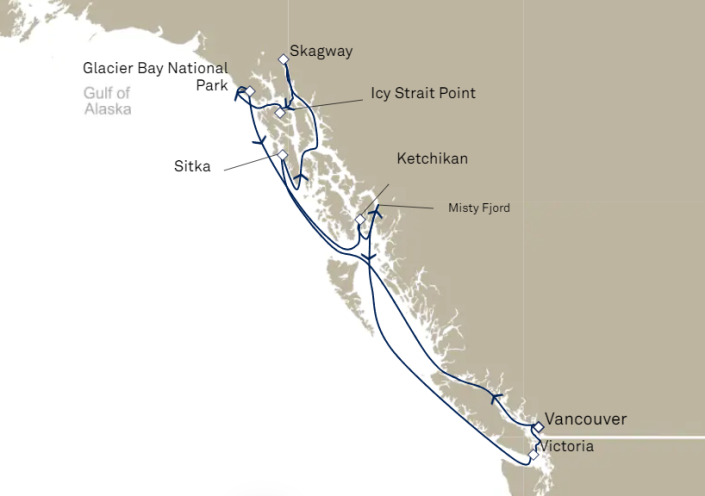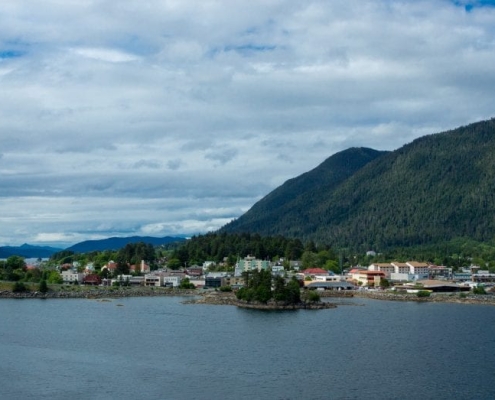Jun 20, 2024
Arrives Morning
Departs Evening
The capital of British Colombia, Victoria, possesses a unique blend of historic charm and contemporary charisma. It offers a wide variety of exquisite sights that draw visitors from around the world.
Victoria port guide.
Nestled on the southern coast of Vancouver Island, British Columbia’s capital city, Victoria, is an intoxicating blend of historic streets, Victorian architecture and dramatic craggy coastlines. Here you’ll find a perfect balancing act between old and new, where the legacies left by indigenous populations are imprinted alongside fairy-tale castles and gardens that stay in bloom year-round.
Hop in a seaplane and take in the breathtaking scenery from up high, step back through time at the Royal BC museum or simply absorb the magic of meandering streets and atmospheric squares. Victoria’s character and history is sure to enchant you, while its burgeoning culinary scene offers everything from farm-to-table bistros and vegan-friendly cafés, to traditional teahouses and colorful microbreweries.
Top landmarks and sights in Victoria.
From historic houses, dedicated to legendary artists, to exquisite castles and Victorian buildings with royal connections, Victoria is awash with sights to see and experiences to savor.
Overlooking the harbor, you’ll find one of the city’s oldest and most famous hotels, the Fairmont Empress. Opened in 1908, the building is a classic example of turn-of-the-century architecture, with countless celebrities and royal visitors electing to stay here over the years.
Traveling just twenty minutes from downtown Victoria brings you to Hatley Park, an Edwardian estate that’s now a national historic site. Together with the magnificent Hatley Castle, the estate also offers beautifully manicured Italian and Japanese gardens, miles of forested walking trails and a rose garden that produces the most intoxicating scent, when in bloom.
Craigdarroch Castle is yet another national historic site that’s a must see on a Victoria, BC, cruise. Built in Victorian times by coal Baron, Robert Dunsmuir, the building is a joy to explore, with impressive period details, decorative stained-glass windows, and a tower offering incredible views over Victoria.
Emily Carr House is also a highlight of a cruise to Victoria. A Victoria artist in residence, Carr’s work draws attention to Vancouver Island’s indigenous natives, and touring her former home reveals an intimate portrait into the artist’s life that fans of her paintings won’t want to miss.
Things to see and do in Victoria, British Columbia.
Victoria is an activity-filled destination, steeped in history to uncover, architecture to admire, and outdoor pursuits that only Canada can deliver. Whether you arrive to basking sunshine or a spring shower, you’ll find no shortage of ways to while away the hours in port.
Paying a visit to the city’s Parliament Buildings should be high on your agenda. A free 45-minute guided tour is available to take you behind the scenes, providing a snapshot into Canadian parliamentary proceedings, and a look inside one of the city’s most impressive buildings.
A walk around one of Victoria’s many parks or gardens offers yet another memorable way to pass the time on a BC cruise. You’ll find more than a dozen to choose from, including the 200 acre Beacon Hill Park in Victoria’s downtown, the stunning Butchart Garden (where staying for afternoon tea is a must) and the Abkhazi Gardens, created by Prince and Princess Abkhazi in 1946.
If museums and galleries are more your speed, Victoria’s selection includes the Art Gallery of Greater Victoria and the Avenue Art Gallery, while the Royal BC Museum, Wentworth Villa Architecture Heritage Museum and Aviation Museum, are among its diverse museum offering.
Victoria is also home to Canada’s oldest Chinatown – a gem in itself to seek out. You can access Chinatown via Fan Tan Alley, famous for being Canada’s narrowest street. This slither of a walkway is home to a variety of local independent shops and exudes a charm that’s impossible to resist.
Eating and drinking near Victoria cruise port.
Set amongst thriving farmlands and fish-rich waters, Victoria’s location is a chef’s dream. Hundreds of restaurants, cafés and bistros make-up the city’s superb dining offer, while its markets and microbreweries offer a taste of Victoria that ale and food fans won’t want to miss.
One of the city’s most exciting culinary destinations is Bastion Square – the site of the old Fort Victoria. Here, in the city’s downtown district, you’ll find an eclectic mix of bars and eateries, many offering outdoor seating in the summer. An artisanal market, selling local produce, also pops up here throughout the warmer months.
If seafood is what you’re seeking, you won’t find fresher than Fisherman’s Wharf. A working harbor lined with shops and food stands, a visit here offers the chance to buy today’s local catch, straight off the boat, while its kiosks serve up tasty fare you can perch to eat or walk with. Victoria Public Market, within the Hudson Building, also offers a casual dining experience, but with a wider choice of gourmet vendors.
Afternoon Tea is another of Victoria’s edible highlights. The tradition has been staunchly observed since being introduced by the British in the 1840s, and you’ll find teahouses keeping up the practice at both Butchart and Abkhazi Gardens, as well as the Fairmont Empress Hotel.
A Victoria food and drink tour is the ideal way to appreciate the excellent caliber of the city’s farmed, fished and bottled produce. Choose from tours taking you through Vancouver Island’s vineyards, boating expeditions that blend wine and whale watching, or take a self-guided journey through Victoria’s ale trail.
Shopping in Victoria.
It’s hard to turn a corner without encountering a shopping experience of some description in Victoria. The city offers everything a souvenir-hunting could wish for, from vibrant markets and wine merchants to shopping malls and tiny boutiques hidden off the beaten track.
If fashion is your guilty pleasure, make a beeline for Market Square. Located in Victoria’s Old Town, this historic area is rife with hip and trendy shops, selling handmade fashions from local labels. You’ll also find some fun places to eat nearby.
The Bay Centre, situated in the heart of Victoria’s downtown, offers almost 100 retailers in a single block, many of which are household names. The area is a popular Victoria shopping destination, with jewelry, skincare, homeware and sports apparel among the finds you’ll unearth here.
An equally diverse selection of shops can be found within the Mayfair Shopping Centre, which unites more than 120 retailers, while Uptown offers an open-air shopping environment that blends international brands and local boutiques.
Victoria culture and history.
Indigenous, British and Asian settlers have all helped to shape Victoria over the years, while the city’s connection to British royalty (Fort Victoria was named for Queen Victoria) has also left a lasting impression.
For thousands of years, Vancouver Island was exclusively inhabited by First Nations People, until the arrival of Captain James Cook in 1778 marked the start of non-aboriginal settlers. The Fraser River Gold rush of 1858 later attracted over 30,000 prospectors in 1858, and soon after Chinese immigrants followed to work on the construction of the Canadian Pacific Railway.
Victoria was proclaimed the capital of British Columbia on July 21st 1871 and throughout the 20th century evolved rapidly. Today the city is home to Canada’s western naval base and educational institutions including the University of Victoria. Its location affords it a pleasant climate, and despite its modernization, the city still retains deep historical ties with its First Nations heritage.
Victoria port facilities and location.
Victoria has been welcoming cruise ships since 1978, and is one of the busiest ports in the Alaska cruise season, hosting hundreds of ships and thousands of passengers throughout April to October, each year.
Cruises to Victoria call at Ogden Point Terminal, situated around 1.5 miles from the city’s downtown. The port has two piers for cruise ships that can accommodate up to three ships at any one time. Shuttle buses are available to ferry passengers from the terminal to downtown, or you can take a taxi if you have another destination in mind.
Rickshaw drivers and horse-drawn carriages can also frequently be found outside the cruise terminal, while gift shops, an exchange bureau, and bicycle rental are among the facilities available to those arriving into Victoria by cruise ship.












